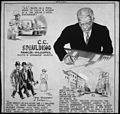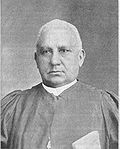The civil rights movement portal The civil rights movement was a social movement in the United States from 1954 to 1968 which aimed to abolish legalized racial segregation, discrimination, and disenfranchisement in the country, which most commonly affected African Americans. The movement had origins in the Reconstruction era in the late 19th century, and modern roots in the 1940s. After years of nonviolent protests and civil disobedience campaigns, the civil rights movement achieved many of its legislative goals in the 1960s, during which it secured new protections in federal law for the civil rights of all Americans. Following the American Civil War (1861–1865), the three Reconstruction Amendments to the U.S. Constitution abolished slavery and granted citizenship to all African Americans, the majority of whom had recently been enslaved in the southern states. During Reconstruction, African-American men in the South voted and held political office, but after 1877 they were increasingly deprived of civil rights under racist Jim Crow laws (which for example banned interracial marriage, introduced literacy tests for voters, and segregated schools) and were subjected to violence from white supremacists during the nadir of American race relations. African Americans who moved to the North in order to improve their prospects in the Great Migration also faced barriers in employment and housing. Legal racial discrimination was upheld by the Supreme Court in its 1896 decision in Plessy v. Ferguson, which established the doctrine of "separate but equal". The movement for civil rights, led by figures such as W. E. B. Du Bois and Booker T. Washington, achieved few gains until after World War II. In 1948, President Harry S. Truman issued an executive order abolishing discrimination in the armed forces. In 1954, the Supreme Court struck down state laws establishing racial segregation in public schools in Brown v. Board of Education. A mass movement for civil rights, led by Martin Luther King Jr. and others, began a campaign of nonviolent protests and civil disobedience including the Montgomery bus boycott in 1955–1956, "sit-ins" in Greensboro and Nashville in 1960, the Birmingham campaign in 1963, and a march from Selma to Montgomery in 1965. Press coverage of events such as the lynching of Emmett Till in 1955 and the use of fire hoses and dogs against protesters in Birmingham increased public support for the civil rights movement. In 1963, about 250,000 people participated in the March on Washington, after which President John F. Kennedy asked Congress to pass civil rights legislation. Kennedy's successor, Lyndon B. Johnson, overcame the opposition of southern politicians to pass three major laws: the Civil Rights Act of 1964, which prohibited discrimination based on race, color, religion, sex, or national origin in public accommodations, employment, and federally assisted programs; the Voting Rights Act of 1965, which outlawed discriminatory voting laws and authorized federal oversight of election law in areas with a history of voter suppression; and the Fair Housing Act of 1968, which banned housing discrimination. The Supreme Court made further pro–civil rights rulings in cases including Browder v. Gayle (1956) and Loving v. Virginia (1967), banning segregation in public transport and striking down laws against interracial marriage. (Full article...) Selected article -The sit-in movement, sit-in campaign, or student sit-in movement, was a wave of sit-ins that followed the Greensboro sit-ins on February 1, 1960, led by students at North Carolina Agricultural and Technical Institute (A&T). The sit-in movement employed the tactic of nonviolent direct action and was a pivotal event during the Civil Rights Movement. The sit-in movement took place during the 1960s, but sit-ins were occurring all over America many years before then. The idea for sit-ins first stemmed from the sit-down strikes during the labor movement. Due to the success of sit-down strikes, similar peaceful protest tactics were used to fight for civil rights. Some of the most influential sit-ins prior to the sit-in movement occurred in Chicago, Illinois in 1943. These sit-ins lead by CORE set a prime example of how sit-ins work and why they are effective. African-American college students attending historically Black colleges and universities in the United States powered the sit-in movement. Many students in the United States followed by example, as sit-ins provided a powerful tool for students to use to attract attention. The students of Baltimore made use of this in 1960 when many used the efforts to desegregate department store restaurants, which proved to be successful lasting about three weeks. This was one small role Baltimore played in the civil rights movement of the 1960s. The city facilitated social movements as it saw bus and taxi companies hiring African Americans in 1951–1952. Sit-ins also frequently occurred in segregated facilities in Oklahoma City between 1958 and 1964. (Full article...) General imagesThe following are images from various civil rights movement-related articles on Wikipedia.
Related portalsWikiProjectsSelected biography - Tom David Kahn (September 15, 1938 – March 27, 1992) was an American social democrat known for his leadership in several organizations. He was an activist and influential strategist in the Civil Rights Movement. He was a senior adviser and leader in the U.S. labor movement. Kahn was raised in New York City. At Brooklyn College, he joined the U.S. socialist movement, where he was influenced by Max Shachtman and Michael Harrington. As an assistant to civil rights leader Bayard Rustin, Kahn helped to organize the 1963 March on Washington, during which Martin Luther King Jr. delivered his "I Have a Dream" speech. Kahn's analysis of the civil rights movement influenced Bayard Rustin (who was the nominal author of Kahn's "From Protest to Politics"). (This article, originally a 1964 pamphlet from the League for Industrial Democracy, was written by Kahn, according to Horowitz (2007, pp. 223–224). It remains widely reprinted, for example in Rustin's Down the Line of 1971 and Time on two crosses of 2003.) (Full article...) Selected image - A. Philip Randolph and other civil rights leaders on their way to Congress during the March on Washington, 1963.
Did you know?
TopicsSubcategoriesThings to doAssociated WikimediaThe following Wikimedia Foundation sister projects provide more on this subject:
Discover Wikipedia using portals
|
© MMXXIII Rich X Search. We shall prevail. All rights reserved. Rich X Search
























































